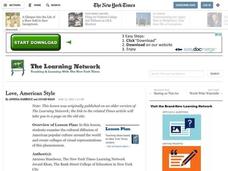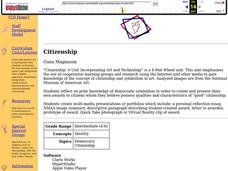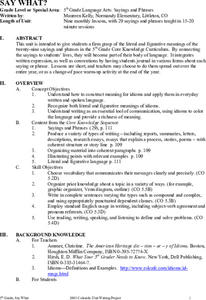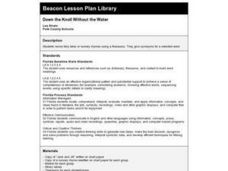Curated OER
Working 9 to 5 in Ancient Egypt
Students create a pyramid diagram that reflects the social order in ancient Egypt and compare the ancient social order with the social order in our world today.
Curated OER
Folk Genres
Students classify folk life traditions into folk genres. They create folk genre museums by laying down their images or postcards wherever they see a relationship. They give each an image to examine in depth and decide which folk genre...
Curated OER
Love, American Style
Students examine the cultural diffusion of American popular culture around the world and create collages of visual representations of this phenomenon. Causes and effects of the cultural diffusion of American popular culture around the...
Curated OER
The Teller of the Tale, Part 3
Students practice use of volume, stress, pacing, enunciation, eye contact, and gestures needed to meet the needs of the audience when presenting their own tales based on Chaucer. They receive teacher and student feedback and prepare to...
Curated OER
Somewhere in the Middle
Young scholars investigate the cease-fire between Israel and Lebanon in August of 2006. The geographic region known as the Middle East is examined and maps created with information on border and territory disputes.
Curated OER
On the Road Again
Students examine migration patterns in Africa and China. They watch excerpts from a documentary, define key vocabulary words, complete various student organizers, and create a poster.
Curated OER
Learning About Magnets
Students discuss which objects attract magnets and which ones will not. They work in small groups to to discuss the concept of magnets and why certain objects attract magnets and some don't and then they experiment with them.
Curated OER
A Flag for Mars
Pupils investigate the historical use of flags on Earth, debate ownership issues for interplanetary exploration, and design a flag for Mars. The implication of placing a flag at a location forms the focus of the instructional activity.
Curated OER
Dinosaurs-Eoraptor
Young scholars explore the Eoraptor. For this dinosaurs lesson, students read facts about the habitat and eating habits of the Eoraptor and illustrate a picture of the dinosaur.
Curated OER
Transportation and Communication Timeline
Students discuss the growth of transportation and communication technology since 1500 C.E. Individually or in groups, they research lists of developments in the two areas. Finally, students create timelines indicating the development...
Curated OER
Jints and Hannah
Students examine the relationship between slave owners and slaves. After viewing a photograph with her owner, students discuss the action of the photo and what it may or may not signify about their relationship. They read various...
Curated OER
Creating a Pot: Repetition as a Unifying Design Element
Students use subjects, themes, and symbols that demonstrate knowledge of contexts, values, and aesthetics that communicate intended meaning in artworks.
Curated OER
US Constitution And Federal/State Relationship
Young scholars examine the Constitution for references to the relationship between state and federal governments. They examine Supreme Court cases for examples of the division of government between state and federal powers.
Curated OER
Can We Live Without Government?
Third graders explore the role that the government plays in the lives of its citizens.
Curated OER
A Postcard from America by Robert Olen Butler
Students read "A Postcard from America" by Robert Olen Butler and complete comprehension activities for the text. In this close reading lesson, students view postcards and read the example text. Students complete close reading activities...
Curated OER
Citizenship
Pupils reflect on characteristics of good citizens, examine democratic symbolism, create an award and choose an individual to receive the award as part of this lesson on citizenship. Lesson ties together social studies, language arts,...
Curated OER
Mark Twain- Teaching About American Authors
Mark Twain lesson plans can shed light on his famous works, like "The Adventures of Tom Sawyer."
Curated OER
Say What?
Students explore the literal and figurative meanings of twenty-nine phrases and sayings. This unit of nine lessons integrates written expression and convention to demonstrate the value of idioms to the language.
Curated OER
Comparing the Ancient and Modern Olympics: A Venn Diagram
Students compare and contrast today's Olympic Games to those held in ancient Greece. They read newspapers, conduct Internet research, watch TV coverage of current Olympic Games and organize their findings on a Venn diagram.
Curated OER
Approaching Walden
Eleventh graders examine their natural surroundings as a way to begin thinking about an abstract idea. They analyze and compare or contrast the rhetorical stategies of two essayists. Students interpret and evaluate images culled from...
Curated OER
Fictional Hereos
Students are introduced to the definition of a hero. As a class, they compare and contrast the difference between non-fictional and fictional hereos they have read about. They read a story, create a story map of one of the heroes and...
Curated OER
The Art of Paraphrasing
Tenth graders participate in an activity in which they practice paraphrasing sections of primary and secondary documents. They are to share their paraphrasing with the class to help with their confidence speaking in front of a group.
Curated OER
Female Poets Speak For Themselves
Student examine selected works of twentieth-century female poets that speak to the stereotypes about women inherent in Western culture. Individually, students explore these stereotypes and their experience with them. Students create a...
Curated OER
Down the Knoll Without the Water
Students use a thesaurus to find synonyms for selected words in fairy tales.

























